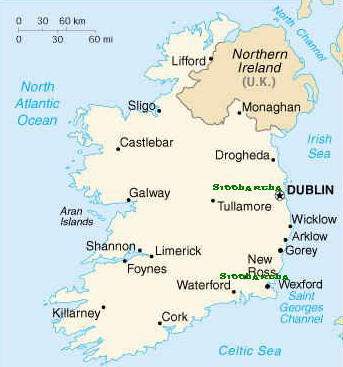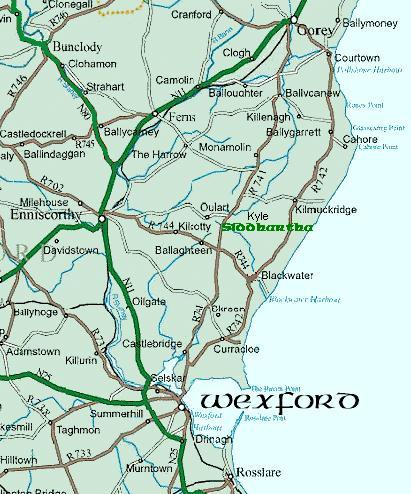|
Ireland is an island
that lies in North West
Europe, separated from
Britain by the Irish
Sea. Dublin is the
capital of the Republic
of Ireland and is
Ireland’s largest city.
It is located on the
east coast of Ireland,
overlooking Dublin Bay.
Wexford is located much
further south, but also
on the east coast of the
island.

About
Dublin
Dublin is the capital
and largest city in
Ireland near the
midpoint of Ireland's
east coast, at the mouth
of the River Liffey.
Founded as a centre of
Viking settlement, the
city has been Ireland's
capital since mediaeval
times.
The name Dublin is a
derivative of 'Dubh
Linn' (Irish,
meaning 'black pool').
The common name for the
city in Modern Irish is
'Baile
Átha Cliath'
('The Settlement of the
Ford of the Reed
Hurdles'), which refers
to the settlement,
founded in 988 by High
King Mael Sechnaill II,
that adjoined the town
of Dubh Linn proper at
the Black Pool.

About
Wexford
All counties in Ireland
have their own story and
in a land steeped in
myth and legend, Wexford
is no exception. The
origin of County Wexford
is lost in the mists of
time but legend tells us
that when Garman Garbh
was drowned on the
mudflats in waters
released by an
enchantress, the vast
expanse of harbour thus
created was named The
Lake of Garman or Loch
Garman, the Gaelic name
for Wexford.
The origins of Wexford
can also be traced to
the Celtic Tribes who
moved Westward across
Europe and were
attracted to the natural
harbour of Loch Garman
on the South East corner
of Ireland. Although
once maurading warriors
the Vikings did settle
well in Wexford. The
name Wexford is derived
from the Viking
Weissford the “Land of
Mud Flats”. Evidence of
it's Celtic and Viking
past is frequently being
discovered in
archaeological digs in
Wexford.
From early
Celtic and
Nordic beginnings
Wexford
has become a thriving
cosmopolitan hub.
About
Oulart
The picturesque village
of Oulart is situated
approx. 22 km from Gorey
town just off the R741
road towards Wexford. On
approaching the village,
Oulart Hill which is
synonymous with the 1798
history in Co. Wexford
is well signposted.
Also located on Oulart
Hill is Tulach a'
tSolais which represents
the divide between the
old and the new world.
Other places of interest
in Oulart. The grave of
the six Insurgents who
were killed on Oulart
Hill in the 1798
Rebellion.
Reconstructed 1798
Chapel, St.Patrick's
Church, which is early
19th century, 1798
Monument, which was
constructed in 1898,
reconstructed 1798
house, and the North
Cork Lane. Also located
close to Oulart is
Meelnagh Cemetery which
has some headstones
dating back to the early
18th century.
Siddhartha
|
Wexford is now where you
will find Siddhartha
Tibetan Terriers
enjoying the Sunny South
East weather with more
annual sunshine than any
other county in Ireland.
How do I get to
Wexford BY AIR:
Fly with
Aer Lingus
or
Ryanair,
and your
National
Airline
may also
have regular flights to
Dublin
or
Cork
Airport.
From
Dublin Airport or Cork
Airport?
There is
direct access to Wexford
by both
Bus and Rail
How do I get to
Wexford BY FERRY:
Both
Irish Ferries
and
Stenaline
have regular ferry
sailing services between
Ireland the United
Kingdom and Mainland
Europe.
|
|
|